Black Sea Shipyard: TAKR "Varyag"
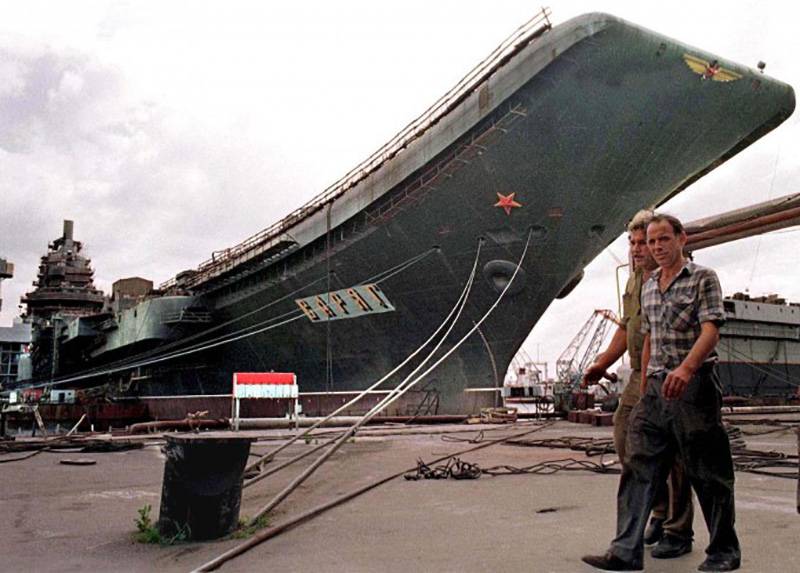
In 1985, no one in the plant, and in everything then, seemed to be an indestructible Soviet Union, could not have imagined that the future aircraft carrier would be an excellent replenishment not of the Soviet, but of the Chinese naval fleet. But this will happen later. In the meantime, full of labor enthusiasm, the workers of one of the country's largest shipbuilding centers were preparing to launch Leonid Brezhnevto continue the baton of building aircraft carriers at a new stage.
And again "Riga" ...
The decision to build a second ship for the 1143.5 project was made in 1983. From the head ship (renamed shortly after the laying in honor of the deceased General Secretary of the CPSU Central Committee to Leonid Brezhnev), the new cruiser was inherited from Riga. The construction of "Riga" began immediately after the release of the slipway number "0", when the lead ship of the project 1143.5 was towed to the outfitting quay of the Black Sea plant.
Since the plant received an order to build another aircraft-carrying cruiser two years before the Leonid Brezhnev’s descent, the 106 order had been thoroughly prepared for the start of construction. The main turbo gear aggregates of the Kirov factory were delivered to the enterprise in a timely manner. Using our own power, 8 boilers were manufactured in advance. Other materials and equipment were procured in advance. All these measures allowed to mount the turbines and boilers on the embedded bottom sections, which were waiting in the wings on the pre-stove plate.
The heavy aircraft-carrying cruiser “Riga” was officially laid on the stocks of the “0” number of the Black Sea Shipyard 8 in December 1985 of the year. The bottom sections of the forward machine-boiler compartment with two turbo-gear units and four boilers were installed as mortgages. During the construction of the 106 order, in contrast to the 105 order, not a single technological cut-out in the case for loading mechanisms was made - everything was mounted directly in blocks.
It was assumed that "Riga" would be identical to "Leonid Brezhnev", but already in the summer of 1986, a resolution of the USSR Council of Ministers was issued to change a number of tactical and technical characteristics of the ship. First of all it concerned the radio-electronic equipment and means of electronic warfare. Instead of the Mars-Passat radar complex, the cruiser should have received a more advanced Forum. The system of electronic countermeasures "Cantata-11435" was decided to replace the new TK-146 "Constellation-BR". Such castling demanded redevelopment and rework more spacecraft 150. This mainly concerned the island superstructure.
Forced alterations delayed the building phase of the construction of Riga on 9 months. The ship was already ready for descent with trunk cables tightened into the hull - several hundred workers of the Era Nikolaev plant were employed in these works.
During the construction of the hull of the heavy aircraft-carrying cruiser, the Black Sea Plant was first confronted with the lack of capacity of two cranes of Finnish production, which together could raise the structure weighing up to 1400 tons. The energy compartments No.3 and No.4 with the equipment installed in them exceeded this value, and therefore they had to be formed directly on the slipway.
The ship was generally ready for launch by November 1988. The day of the ceremony was scheduled for November 25. The solemn event should have been attended not only by high naval ranks, but also by representatives of numerous design bureaus, primarily Nevsky, Mikoyan and Sukhoi. Pilots Heroes of the Soviet Union Viktor Pugachev and Toktar Aubakirov were invited as guests.
Arrived and the delegation of the city of Riga. According to the memoirs of the chief builder of the order 106 Alexei Ivanovich Seredin, the guests from the Baltic could not understand why such a large and powerful warship received the name of their city. I had to explain to them that this fact is a long-standing naval tradition: to assign the names of large settlements to large ships. Most likely, the perplexity of the Latvian guests was caused not so much by the lack of knowledge of the naval traditions, but by the process of destabilization of the country, which is gaining momentum, called “perestroika”.
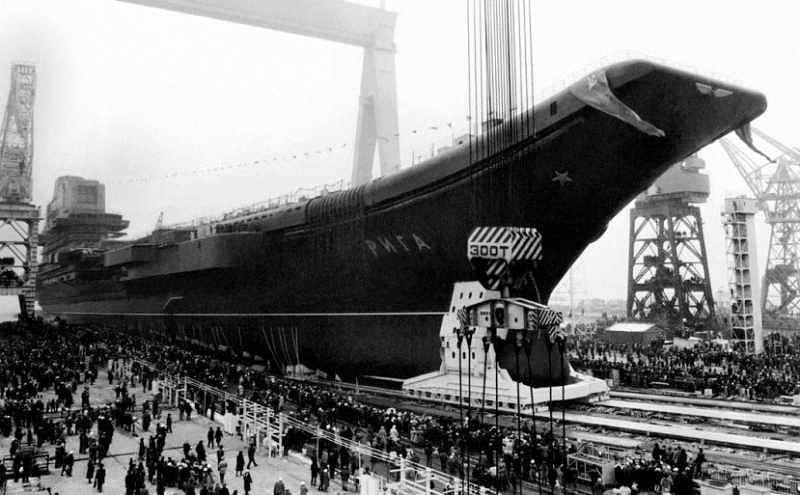
The descent of "Riga" went smoothly. The launching weight of the ship reached 40 thousand tons - one thousand tons more than the previous, 105 order. After launching the cruiser was towed to the extension wall, where it was connected to shore power sources.
The completion of the ship was not without difficulties. Despite the mostly timely supplies of equipment and materials, there was a shortage of labor. The priority task for the plant was the fastest completion of work on the 105 order, which was being prepared for testing. The delivery to the Riga fleet was planned for 1993 year, however, unfortunately, these plans were not destined to be realized.
Political processes of varying degrees of destructiveness, but destructive in their large aggregate, were already in full swing in the country. Once one of the most prosperous economically regions of the USSR, the Baltic states, fevers or fevers of an ever more distinct nationalistic hue were feverish. On the night of March 11 1990, the Supreme Council of Latvia proclaims the independence of the republic and its withdrawal from the USSR. So far, of course, unilaterally. This fact was reflected in the renaming of the heavy aircraft carrier cruiser under construction in Nikolaev. 19 June 1990, by order of the Commander-in-Chief of the USSR Navy, he was renamed from Riga to Varyag.
The economic situation in the Soviet Union was rapidly deteriorating - inflation began and an increasingly less controlled rise in prices. The initial cost of a heavy aircraft-carrying cruiser at 500 million rubles reached 1990 billion in 1 prices and confidently crossed it. Some difficulties with financing began, however, the work continued quite intensively.
In the summer of 1991, the sovereign winds blew in Kiev. In August, 1991 Ukraine proclaimed independence. In the autumn of the same year, on the eve of the presidential election, the main contender for this post, and in the recent past, the second secretary of the Central Committee of the Communist Party of Ukraine, Leonid Makarovich Kravchuk, visited the Black Sea Shipbuilding Plant. The industrial power that was seen “impressed” Kiev officials - Kravchuk called CSV a real gem. Kravchuk also promised the factory workers that the construction of aircraft carriers would continue: in addition to the expanding Varyag, the 107 order body, which did not take place atomic heavy cruiser Ulyanovsk, was being built with might and main.
The financial settlement system of the Navy still continued to operate in an already agonizing state, and for 1991 a year all work on Varyag was paid. The plan’s overfulfilment was fully paid and compensation was additionally transferred due to price increases - about 100 million rubles.
Uncaused
1992 has come the year. By this time, after the Belovezhsky collusion, the Soviet Union ceased to exist. Politicians who considered themselves winners began to divide the colossal legacy of the failed state. The flywheels and gears were still spinning just recently on a single economic organism, but their rotation slowed down steadily. In January, 1992, Director of the Black Sea Shipbuilding Plant, Yury Ivanovich Makarov, began sending cipher telegrams to Kiev and Moscow for the renewal of an agreement on financing further work at Varyag, which by this time was in a fairly high degree of readiness - about 67%.
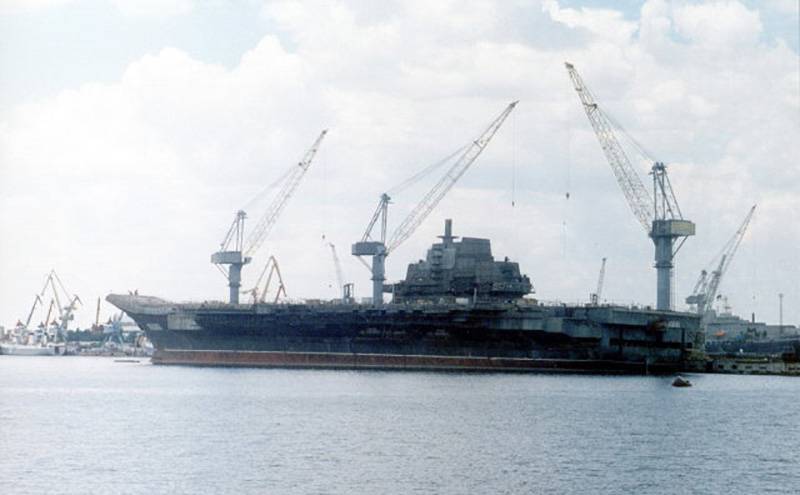
Neither the heads of government, neither the two presidents, nor the ministries of defense gave a clear answer. Or did not deserve the answer. Of course, it was impossible for the Black Sea Plant to complete the construction of such a large and complex ship, in the creation of which many hundreds of enterprises and institutions of the entire Soviet Union took part. Director Yuri Ivanovich Makarov was forced to make a difficult decision to stop work on the 106 order and temporary, as it seemed, conservation.
The plant was preserved exclusively at its own expense: first of all, appropriate procedures were carried out with boilers and main machinery. Care and protection of the corps. The fact is that before the state tests the previous ship "Admiral Kuznetsov" was docked to inspect and clean the bottom. During this procedure, corrosion of the underwater part of the hull, especially in its rear part, was noted. To avoid this on the Varyag, a special protection was mounted - the entire cruiser was edged with a belt of cables, to which zinc protectors were hung.
Subsequently, already in China, the Varyag Corps was well preserved, despite the long-term parking at the plant wall and the lack of docking. The fate of the ship turned out to be a big question, whose decision over the years caused more and more doubt. The economic situation in the former Soviet Union deteriorated - becoming independent, but not able to get rich, his republics were preoccupied with their own survival more than with projects to create an aircraft carrier fleet.
Still remaining a huge shipbuilding center, the Black Sea Plant was forced to find means to maintain its own existence - instead of military ships, construction of tankers began for the Greek customer. The 107 order, which did not take place at Ulyanovsk, was hastily sawn into scrap metal, and piles of cut high-quality ship steel lay open-air throughout the enterprise for a long time.
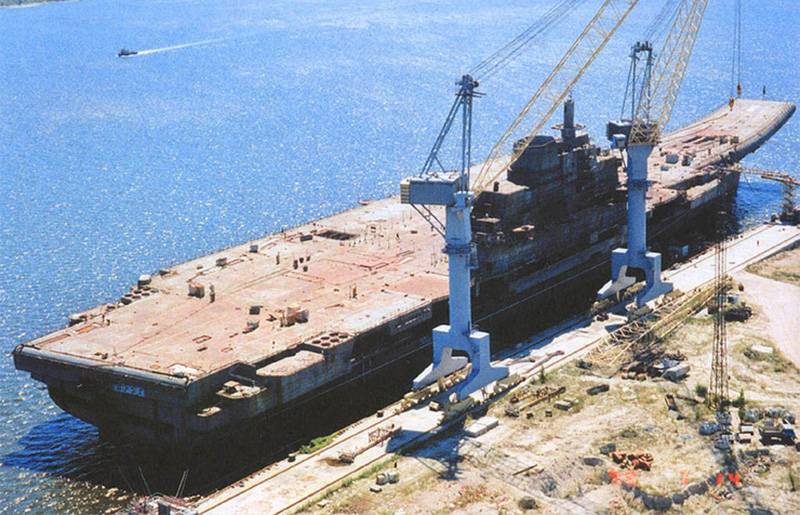
Standing at the extension wall, Varyag was waiting for its fate. In the 1993 year, Russia finally takes some steps in an attempt to definitely decide the fate of the ship. The idea arises of creating a certain interstate coordination center for the completion of a heavy aircraft-carrying cruiser. In order to assess the situation on the spot, Prime Ministers of Russia and Ukraine Viktor Chernomyrdin and Leonid Kuchma arrived in Nikolaev. They were accompanied by a whole delegation of representatives of the presidents: Sergei Shakhrai and Ivan Ivy, numerous ministers and their assistants. Among the arrivals was the then commander-in-chief of the Russian Navy Felix Nikolayevich Gromov. The heavy aircraft-carrying cruiser Varyag belonged to the number of ships that left none of those who saw it indifferent. And the arrivals of the capital guests were no exception.
After inspecting the plant and the unfinished ship, a joint meeting began, at which the discussion of the conditions for the transfer of Varyag to Russia began. Initially, the then director of the Black Sea Shipbuilding Plant, Yury Ivanovich Makarov, addressed the high and not very international heads. He reported that the cruiser’s technical readiness reached almost 70%. Moreover, all these percentages have already been paid by the Soviet Navy, and the money received by the plant. Consequently, the question of the sale by Ukraine of the Russian cruiser rested against the financing of the remaining unfinished 30%.
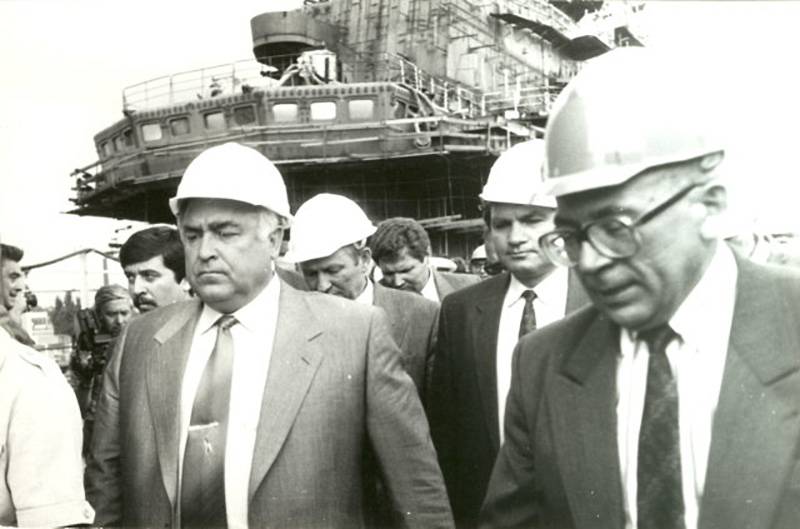
However, the Ukrainian side had its own opinion on this matter. She believed that the Russian Federation should pay the full cost of the ship - the winds of a market economy, so persistently inflated by Gorbachev, by that time did not need outside help. The negotiation process was at a standstill, the situation was heated. Viktor Chernomyrdin asked Makarov: what is necessary for the completion of a ship of this class? Hot-tempered and not inclined to go into his pocket for a strong word, the director of the Black Sea Plant replied to the Prime Minister that such an operation requires a military-industrial complex, the State Planning Committee, nine ministries and the Soviet Union.
Leonid Kuchma was displeased with the answer, and Chernomyrdin praised Makarov for sincerity. Some, in particular, the representative of the President of Ukraine Ivan Plyushch, the former director of the state farm, and in the recent past the first deputy chairman of the Kiev Regional Executive Committee of the Communist Party of Ukraine, began to lecture Makarova, under whose leadership a total of about 500 ships and ships were built, how to properly build aircraft carrier. At the same time, Ivy did not fail to point out that the factories of the military-industrial complex in general lived easily and had forgotten how to work.
It was too much. Makarov, whose state of such nonsense was already approaching the temperature of intranuclear processes, was forced to interrupt Mr. Ivy’s strategic reflections on the role of the military-industrial complex by the threat of physical interventions. Negotiations are deadlocked. It was not only a matter of fundamentally different views on the ship’s sale price — it was clear that in conditions of total collapse, the disastrous consequences of the collapse of the Soviet Union, it would not be possible to complete the construction of a heavy aircraft-carrying cruiser. Alone, it was then beyond the power of either Russia, or even more so Ukraine. The fate of the ship was still uncertain.
To be continued ...
- Denis Brig
- CSY: “Tbilisi” - “Admiral Kuznetsov”, completion and service of a heavy aircraft-carrying cruiser
CSV: TAKR "Riga" - "Leonid Brezhnev"
CSY: aircraft carriers and espionage
CSY: rolls of the project "Atlantic"
ChSZ: military weekdays of dry-cargo ships of the Nikolaev construction
CSY: reconstruction of the plant and the transition to large-block assembly. TAKR "Baku"
CSY: the development of heavy aircraft-carrying cruisers. "Minsk" and "Novorossiysk"
CSY: TAKR "Kiev"
CSY: research vessel "Akademik Sergey Korolev"
CSY: whalers and anti-submarine cruisers
Information